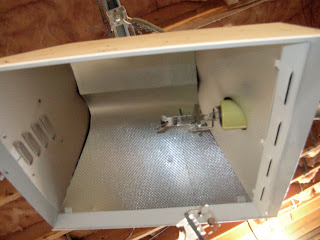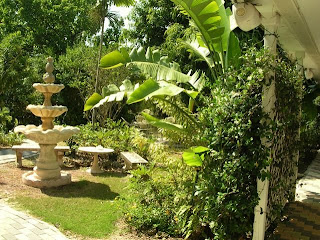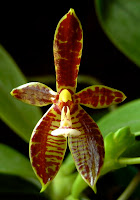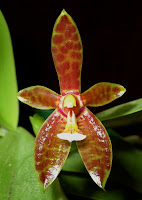Plant Sales Live on JuliaRedman.com
 Many people have discovered the joy of wildflowers that re-seed or spread, generally popping up randomly in your yard. I'm here to tell you that if you loosen the reins on your veggie patch you can have the same kind of fun. Three years ago I planted a loose-leaf lettuce mix. Every year since then I've had lettuce without planting it. I just let my favorites go to seed.
Many people have discovered the joy of wildflowers that re-seed or spread, generally popping up randomly in your yard. I'm here to tell you that if you loosen the reins on your veggie patch you can have the same kind of fun. Three years ago I planted a loose-leaf lettuce mix. Every year since then I've had lettuce without planting it. I just let my favorites go to seed.
Loose leaf lettuce is great because you can snap off a mass of leaves and they'll just grow new ones as long as you leave the central crown. The flowers are kinda cute too. They have yellow or white daisy-like panicles of flowers. Although they do look a bit weedy when the fluffy mass of seeds appear.
Speaking of weeds, you'll need a good amount of open ground for this to work, so you'll have to tolerate some amount of weeds on your veggie beds. The lettuce always ends up in different places (occasionally there's a plant in the lawn) but crop rotation is a good thing anyway.
I often find that the lettuces are up as early as when the crocus blooms, so by the time of daffodils you might have a good salad going, especially if you do the same thing with radishes.
 This was a busy weekend. Among my chores was the task of moving the plants living under the 1000W lamp in the basement to the screened in porch. This means I get to turn off that energy hog for the summer. Yay!
This was a busy weekend. Among my chores was the task of moving the plants living under the 1000W lamp in the basement to the screened in porch. This means I get to turn off that energy hog for the summer. Yay!
Actually, what you see in the photo isn't everything that lives there in the winter, since some of it was already brought upstairs. What I have living there includes cattleyas, assorted passifloras, aloes, strelitzias, a couple dutchman's pipe species, and a few odd caudex species and ferns. And the big fellow on the right there is a Zantedeschia 'Hercules' seedling, which is just about to bloom for the first time. Its a wide variety, isn't it? I actually would like to downsize the cattleya variety, since I'm not going to be breeding them and I'd like to grow more passifloras. I was fortunate enough to get my first lamp as a hand-me-down, complete with a track. It has been very useful in allowing me to overwinter things I wouldn't otherwise have space for. This winter the original bulb blew itself and the safety glass lens to bits. (photo at right) Let this be a lesson to all of ya's. Replace your bulb within a reasonable time of its estimated life span. Not only does it put out fewer lumens while sucking more power when its old, if you really push it it will just short out and blow up. There was glass everywhere. I'm still finding it in pots.
I was fortunate enough to get my first lamp as a hand-me-down, complete with a track. It has been very useful in allowing me to overwinter things I wouldn't otherwise have space for. This winter the original bulb blew itself and the safety glass lens to bits. (photo at right) Let this be a lesson to all of ya's. Replace your bulb within a reasonable time of its estimated life span. Not only does it put out fewer lumens while sucking more power when its old, if you really push it it will just short out and blow up. There was glass everywhere. I'm still finding it in pots.
When this happened I thought about replacing the lamp with an array of compact fluorescent lamps in hopes of being more energy efficient with my compulsive hobby. But after looking into the available goods, their specs and prices, I found that it would cost something like $900 to get all the bulbs and fixtures needed, and would NOT use any less electricity than my HID lamp. (Feel free to double check this for yourself in case I went wrong somewhere.) Oh well. New bulb + reflector and lens (used with existing track and ballast) only cost ~$200.
Anyway, those plants, plus some others that live upstairs in the winter, are outside for the summer. Some will be staying on the porch, some will be going out on the patio once they get used to the new environment. I still have lots and lots of stuff inside though. Perhaps I'll tell you about them sometime. :)
 I cranked out these cuties yesterday as a thank you gift for our hosts in FL, just using the cotton yarn I had stashed. I hope they like them. The pattern is quick and simple, and I thought I'd share it for any of you who might also like to use up your stash! (If only it was that easy!!)
I cranked out these cuties yesterday as a thank you gift for our hosts in FL, just using the cotton yarn I had stashed. I hope they like them. The pattern is quick and simple, and I thought I'd share it for any of you who might also like to use up your stash! (If only it was that easy!!)
Materials:
Lily Sugar & Cream Cotton or similar
Colors: Rose, Peach, Yellow, Apple Green, Variegated Blues, Lilac
or colors of choice. You will not need full balls of each. I had half size balls of the yellow and green and after making all 4 of these there is still some leftover.
Size G (4.25mm) crochet hook
Finished size (before washing): 6.5 x 6.75 inches
Instructions:
* With rose, Ch 30.
* Sc in 2nd ch from hook, (ch1, skip 1 st and sc in the next st) across. Ch1, turn.
* Sc in first 2 sts, (ch1, skip 1 st and sc in the next st) across, sc in last st. Ch1, turn.
* Repeat last 2 rows until cloth is the desired size. Example uses 4 rows (2 repeats) for all colors except the variegated blue, which was 6 rows (3 repeats).



I got back in town late Monday night from the trip to FL for the Redlands Orchid Festival in South Florida. It was a good show, but somehow we totally passed the actual show tent. Its kinda small - they don't have displays at this show, only individual plants for awards. But there are something like 60 vendors form 16 countries. Whew! lots to look at! There was a fair amount of sort of average stuff, but also a fair number of good deals and unusual or high quality stuff. Cool t-shirts too!
The festival is held at the Fruit and Spice Park in Homestead. The park has a nice collection of normal and unusual fruit trees and plants. Unfortunately, many of them are not labeled or only have a common name label. The two photos above are from the fruit and spice park. On the left is Pachira aquatica (Guiana chestnut [on label at park], Malabar chestnut, money tree) and on the right is some banana with no ID. They had a nice little Musa forest, including a few dwarf trees, but I don't know their names. We stayed at the Grove Inn while in the area. They also have many edible plants on their property, including sapote, mango, natal plum, barbados cherry, and passifloras. Its a great little place with a comfortable courtyard (photo at left) with several tables and chairs where we ate breakfast every morning, then chilled with the cats and watched the plentiful anoles skittering around. Below left is a little dude claiming a chair leg as his own. On the right is a house gecko that we found hiding out behind a pink loofah. We really loved this place and I'm already thinking up excuses to go back! I very much prefer the bed & breakfast atmosphere to the ordinary hotel.
We stayed at the Grove Inn while in the area. They also have many edible plants on their property, including sapote, mango, natal plum, barbados cherry, and passifloras. Its a great little place with a comfortable courtyard (photo at left) with several tables and chairs where we ate breakfast every morning, then chilled with the cats and watched the plentiful anoles skittering around. Below left is a little dude claiming a chair leg as his own. On the right is a house gecko that we found hiding out behind a pink loofah. We really loved this place and I'm already thinking up excuses to go back! I very much prefer the bed & breakfast atmosphere to the ordinary hotel.

 One of our other stops was Butterfly World. It was surprisingly expensive to get into this place given its relatively small size, but it did have a moderate collection of tropical passifloras (which is mainly why we went) and a big containment area filled with exotic species of butterflies. At left is a photo of a yellow and black critter resting on my hand. While there I procured seeds from several different passifloras. Maybe later this summer I'll have plants to share with everyone!
One of our other stops was Butterfly World. It was surprisingly expensive to get into this place given its relatively small size, but it did have a moderate collection of tropical passifloras (which is mainly why we went) and a big containment area filled with exotic species of butterflies. At left is a photo of a yellow and black critter resting on my hand. While there I procured seeds from several different passifloras. Maybe later this summer I'll have plants to share with everyone!
 This past weekend I mixed and packed seeds for EtsyPHAT's Guerrilla Gardening campaign. Guerrilla gardening is not a new concept, but we don't think it gets enough press. So we've set out to begin supporting the idea of randomly sprucing up neglected spaces, plus just the fun of planting seeds and seeing if they make it and how others react to the sudden appearance of veggies or flowers in what was recently a dirt pancake. For more information, checkout one of our member's great article in Etsy's Storque, as well as the EtsyPHAT blog. And also- be on the lookout for our seed packets! You might find one hanging out on a park bench, in a package you just got in the mail, or any number of other random places. Take them and find them a home where they can enhance your town!
This past weekend I mixed and packed seeds for EtsyPHAT's Guerrilla Gardening campaign. Guerrilla gardening is not a new concept, but we don't think it gets enough press. So we've set out to begin supporting the idea of randomly sprucing up neglected spaces, plus just the fun of planting seeds and seeing if they make it and how others react to the sudden appearance of veggies or flowers in what was recently a dirt pancake. For more information, checkout one of our member's great article in Etsy's Storque, as well as the EtsyPHAT blog. And also- be on the lookout for our seed packets! You might find one hanging out on a park bench, in a package you just got in the mail, or any number of other random places. Take them and find them a home where they can enhance your town!
Tomorrow I'm heading to FL for the Redland orchid festival and a general flowery tour. I'll make sure to post photos when I get back!

 These are two first bloom seedlings of Phalaenopsis thalebanii ('Dark Star' x self). Although the flowers are marked differently, I can't tell what is physically different between this species, cornu-cervi, and all those related species. The exception though is mannii, which is the only species in the group that does not have the large flattened inflorescence.
These are two first bloom seedlings of Phalaenopsis thalebanii ('Dark Star' x self). Although the flowers are marked differently, I can't tell what is physically different between this species, cornu-cervi, and all those related species. The exception though is mannii, which is the only species in the group that does not have the large flattened inflorescence.
 Many people have discovered the joy of wildflowers that re-seed or spread, generally popping up randomly in your yard. I'm here to tell you that if you loosen the reins on your veggie patch you can have the same kind of fun. Three years ago I planted a loose-leaf lettuce mix. Every year since then I've had lettuce without planting it. I just let my favorites go to seed.
Many people have discovered the joy of wildflowers that re-seed or spread, generally popping up randomly in your yard. I'm here to tell you that if you loosen the reins on your veggie patch you can have the same kind of fun. Three years ago I planted a loose-leaf lettuce mix. Every year since then I've had lettuce without planting it. I just let my favorites go to seed. 











